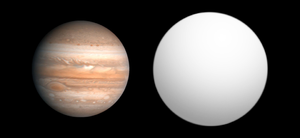- OGLE-TR-132b
-
OGLE-TR-132b Extrasolar planet List of extrasolar planets 
Size comparison of OGLE-TR-132b with Jupiter. Parent star Star OGLE-TR-132 Constellation Carina Right ascension (α) 10h 50m 34.72s Declination (δ) -61° 57′ 25.9″ Distance 4892 ly
(1500 pc)Spectral type F Orbital elements Semimajor axis (a) 0.0306 ±0.0008 AU Eccentricity (e) 0 Orbital period (P) 1.689868 ±3e-06 d Inclination (i) 85 ±1° Physical characteristics Mass (m) 1.14 ±0.12 MJ Radius (r) 1.18 ±0.07 RJ Discovery information Discovery date 14 April 2004 Discoverer(s) Bouchy et al. Detection method Transit Discovery status Published Database references Extrasolar Planets
Encyclopaediadata SIMBAD data OGLE-TR-132b is an extrasolar planet orbiting the star OGLE-TR-132.
In 2003 the Optical Gravitational Lensing Experiment (OGLE) detected periodic dimming in the star's light curve indicating a transiting, planetary-sized object. Since low-mass red dwarfs and brown dwarfs may mimic a planet radial velocity measurements were necessary to calculate the mass of the body. In 2004 the object was proved to be a new transiting extrasolar planet.[1]
 The radial velocity of OGLE-TR-132 over time, caused by the presence of OGLE-TR-132 b.
The radial velocity of OGLE-TR-132 over time, caused by the presence of OGLE-TR-132 b.
The planet has a mass 1.14 times that of Jupiter. Since the planet's inclination is known, this represents the best measured true mass of the planet, rather than simply the minimum mass as is the case when the inclination is unknown. It orbits the star (OGLE-TR-132) in an extremely close orbit, even closer than the famous planets 51 Pegasi b and HD 209458 b. The planet races around the star every 1 day 16.6 hours. The radius of the planet is only 18% larger than Jupiter's, despite the heating effect by the star. Planets of its kind are sometimes called "super-hot Jupiters".[2]
See also
References
- ^ Bouchy, F.; et al. (2004). "Two new "very hot Jupiters" among the OGLE transiting candidates". Astronomy and Astrophysics 421: L13–L16. arXiv:astro-ph/0404264. Bibcode 2004A&A...421L..13B. doi:10.1051/0004-6361:20040170.
- ^ Gillin, M.; et al. (2007). "The transiting planet OGLE-TR-132b revisited with new spectroscopy and deconvolution photometry". Astronomy and Astrophysics 466 (2): 743–748. arXiv:astro-ph/0702192. Bibcode 2007A&A...466..743G. doi:10.1051/0004-6361:20066367.
External links
 Media related to OGLE-TR-132 b at Wikimedia Commons
Media related to OGLE-TR-132 b at Wikimedia Commons- "OGLE-TR-132 b". Exoplanets. http://media4.obspm.fr/exoplanets/base/planete.php?etoile=OGLE-TR-132&planete=b.
- "OGLE-TR-132 B". Extrasolar Visions. http://www.extrasolar.net/planettour.asp?StarCatId=normal&PlanetId=262.
Coordinates:
 10h 50m 34.72s, −61° 57′ 25.9″
10h 50m 34.72s, −61° 57′ 25.9″
This extrasolar planet related article is a stub. You can help Wikipedia by expanding it.
